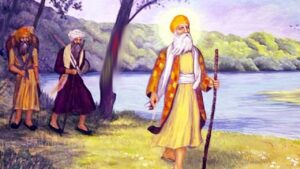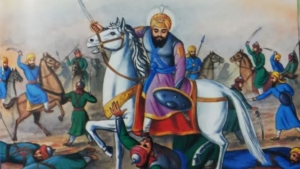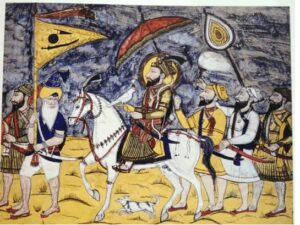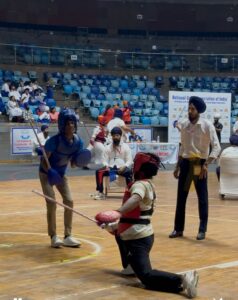


Gatka – Sikh Martial Art of Shastar Vidya and Its Modern Sports Form
Gatka is the traditional Sikh martial art that has its roots in Shastar Vidya – the ancient science of weapons. It is a blend of spirituality, discipline, and self-defense that has been practiced by Sikhs for centuries. Today, Gatka is not only preserved as a cultural heritage but also promoted as a modern sports fight across the world.
What is Gatka?
The word Gatka originally comes from the wooden stick used for practice, but its true essence is much deeper. Gatka is about balance between Miri-Piri – the Sikh principle of combining spiritual devotion (Piri) with temporal responsibility (Miri).
Practitioners of Gatka see weapons not as tools of violence but as sacred gifts to defend truth, justice, and humanity.
History of Gatka and Sikh Shastar Vidya
Guru Nanak Dev Ji and Shastar
Although Guru Nanak Dev Ji is known for spreading peace and divine wisdom, historical sources show that he also carried Salotar (flail) and Neja (spear) during his Udasis (missionary travels). These weapons symbolized readiness and the principle that one should live peacefully but remain prepared to protect righteousness.
Guru Hargobind Sahib Ji
 The sixth Sikh Guru, Guru Hargobind Sahib Ji, introduced formal martial training to the
The sixth Sikh Guru, Guru Hargobind Sahib Ji, introduced formal martial training to the
Sikh community. He wore two swords representing Miri (temporal power) and Piri (spiritual power) and trained Sikhs in the use of swords, spears, and bows. This marked the strengthening of Shastar Vidya.
Guru Gobind Singh Ji
 The tenth Guru, Guru Gobind Singh Ji, carried the martial tradition to its highest level. He created the Khalsa in 1699 and gave Sikhs the identity of Saint-Soldiers (Sant-Sipahi). Under his leadership, Gatka and Shastar Vidya were perfected, ensuring Sikhs were spiritually elevated yet always ready to defend the oppressed.
The tenth Guru, Guru Gobind Singh Ji, carried the martial tradition to its highest level. He created the Khalsa in 1699 and gave Sikhs the identity of Saint-Soldiers (Sant-Sipahi). Under his leadership, Gatka and Shastar Vidya were perfected, ensuring Sikhs were spiritually elevated yet always ready to defend the oppressed.
Significance of Gatka
1. Spiritual Discipline – Every session of Gatka begins with Ardas (prayer). Weapons are treated with reverence, reminding practitioners that power must be guided by faith.
2. Physical Training – Gatka improves agility, stamina, reflexes, and balance.
3. Cultural Heritage – It is an important part of Sikh identity, often performed during Nagar Kirtans, Hola Mohalla, and other Sikh festivals.
4. Defense and Courage – Gatka reflects the Sikh principle of Deg Tegh Fateh – victory to those who feed the hungry (Deg) and protect the weak with the sword (Tegh).
Gatka as a Modern Sports Fight
Modern Gatka Fight is a traditional Sikh martial art that has evolve d into a structured sport recognized at the national level. It is played with sticks (replica of swords) following specific rules and safety measures, making it a competitive yet disciplined combat sport. The School Games Federation of India (SGFI) has officially recognized Gatka, allowing school students across the country to participate and gain certificates that support their academic and sports careers. Additionally, it has found space in the Khelo India initiative and has been featured in the Indian National Games, giving it further credibility and exposure. The inclusion of Gatka in the Pythian Games on the international stage shows its cultural and sporting importance, as it not only promotes physical strength and agility but also preserves the Sikh martial heritage for global recognition.
d into a structured sport recognized at the national level. It is played with sticks (replica of swords) following specific rules and safety measures, making it a competitive yet disciplined combat sport. The School Games Federation of India (SGFI) has officially recognized Gatka, allowing school students across the country to participate and gain certificates that support their academic and sports careers. Additionally, it has found space in the Khelo India initiative and has been featured in the Indian National Games, giving it further credibility and exposure. The inclusion of Gatka in the Pythian Games on the international stage shows its cultural and sporting importance, as it not only promotes physical strength and agility but also preserves the Sikh martial heritage for global recognition.
The structure of the game is designed around scoring points through strikes on permitted body areas while ensuring the safety of players with protective gear. Matches are usually timed, and referees ensure fair play. Players receive certificates at various levels—district, state, national, and international—which enhance their career prospects, though the value of certificates may vary depending on the event’s recognition, Gatka is highly beneficial for players as it improves reflexes, discipline, and confidence, while also providing opportunities for scholarships, admissions, and government job quotas under sports categories. Its growing presence in official sporting bodies ensures that young athletes can pursue Gatka both as a passion and as a career path.
This modern sporting version has made Gatka accessible to youth worldwide, while still keeping its spiritual and cultural roots intact.
